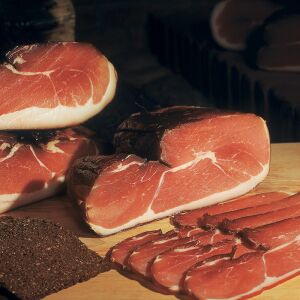Ammerländer Schinken ; Ammerländer Knochenschinken (Ammerland ham)
G.g.A. Ammerländer Schinken is a raw, firm cut of hindquarter ham without bone (Ammerländer Schinken) or with bone (Ammerländer Knochenschinken) with full topside muscle of pig; light smoked colour and mild, lightly spiced flavour (Ammerländer Schinken) or dark smoked colour and strong spiced flavour (Ammerländer Knochenschinken); strong red meat colour when cut; typical smoked aroma; the lean meat has a specific ham flavour, which is rounded off and increased in gastronomic value by the fatty part. The fatty part must have a good aroma; the hindquarter ham required must be taken from pigs of the original "Ammerländer Edelschwein" breed or from pigs with the same structure, which, in terms of the way they are kept and fed, and of their type (meat pigs), can guarantee the desired top quality at the final stage of processing.

Geographical area: Ammerland Rural District
Proof of origin: In the nineteenth century a number of meat processing enterprises were established in the Rural District of Ammerland which began to produce on a larger scale. The establishment of processed meat production on an industrial scale was more or less contemporaneous with the beginning of industrialisation in Europe in the last century. Larger scale production of, among others, the various types of Ammerländer ham (Ammerländer Schinken and Ammerländer Knochenschinken) began at this time, and these hams were delivered to middlemen in urban centres and also exported abroad. Until this industrialization of meat processing, Ammerländer Schinken and Ammerländer Knochenschinken were produced by small operations for a smaller circle of customers and on a smaller scale. Principally, however, Ammerländer hams were produced by local farmers for their own use to a small extent and for urban centres where so-called bacon dealers took them in return for various other goods or bought them for money, since in the long ran the farmers could not afford to consume this food themselves. It cannot be established precisely when the term Ammerländer Schinken [Ammerländer hams] became an umbrella term for the various varieties of ham, but on the basis of historical records it may be deduced that the terms Ammerländer Schinken (Ammerländer boneless ham) and Ammerländer Knochenschinken (Ammerländer ham on the bone) have been in use since around the eighteenth century. Production recipes and methods have gradually become more and more similar over the generations. They were made binding for all producers when the Verein zum Schutz der Herkunftsbezeichnung Ammerländer Schinken e.V. [Association for the protection of the Ammerländer designation of origin] was founded in 1978 with the objective of ensuring that high quality ham continued to be produced in future under the names Ammerländer Schinken and Ammerländer Knochenschinken, retaining the quality features that had become firmly associated with them over many generations.
Method of production: The hindquarter of the pig ham is cured (dry or wet curing, but not by injection) using old methods handed down over the generations. After curing, the ham is further ripened for two weeks in the open air. It is subsequently smoked over a period of at least ten weeks in a separate industrial smoking facility or on the floor of a smoke house without a chimney (in a Kate, country house or farm house). When the producer sells the ham, it must have the following qualities among others: it must be well cured throughout, have an appropriate proportion of fat on the lean part and be dried to a water:protein ratio of 2.5:1.
Link: To produce Ammerländer Schinken and Ammerländer Knochenschinken, the hindquarter ham processed is taken exclusively from the Ammerländer Edelschwein variety of pig or other types of meat pig the meat of which has a firm and meaty structure and which are locally bred or fattened. In the nineteenth century a pig was specially bred for this purpose; it can be classified as a meat pig and has the recognized designation of Ammerländer Edelschwein. This breed of pigs is still kept in some parts of the rural district of Ammerland.
Gastronomy: The Ammerländer Schinken G.g.A. and Ammerländer Knochenschinken G.g.A. can be kept for a rather long period of time if kept in a cool environment. It is advisable to wrap them in a cloth and cover the cut part well, to maintain the hams' right humidity. It is recommendable to keep the slices covered in clingfilm in the refrigerator. The Ammerländer Schinken G.g.A. hams are consumed plain, but can also be used in many preparations. To best enjoy their flavour, it is recommendable to cut the hams by hand, in order to obtain a thick and soft slice, or even dice it, to then cook and use it as an ingredient in other dishes that allow the full savouring of the aroma.
Reference: The European Commission
#ham #hams #smoked #curing #bones #cured #smoking #protein #dice #fat